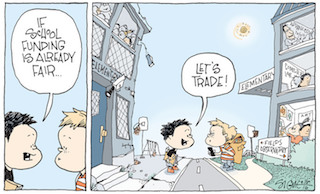“It would be foolish to despise tradition. But with our growing self-consciousness and increasing intelligence we must begin to control tradition and assume a critical attitude toward it, if human relations are ever to change for the better. We must try to recognize what in our accepted tradition is damaging to our fate and dignity—and shape our lives accordingly.” Albert Einstein
The time has come to do more than set aside the month of November for the so-called honoring of Native American History. Speaking as a lifelong and ardent fan of the local professional football team, add one more voice to the chorus of those who believe that the retirement of the name to the annals of history is too long overdue. Roxanne Dunbar-Ortiz addressed this history of the word in “An Indigenous Peoples’ History of the United States” where she points out that, “The settlers gave a name to the mutilated and bloody corpses they left in the wake of scalp-hunts: redskins.”
Many instances of social injustice would likely have polled quite well early in their implementation. It is more likely that the results of the recent poll regarding the team’s name have more in common with the “Stockholm Syndrome” than with indifference to such an objectionable epithet. As Paolo Freire posited in his Pedagogy of the Oppressed, “There would be no oppressed had there been no prior situation of violence to establish their subjugation.”
After moving the team from Boston to Washington, the original owner-and-founder of this franchise, George Preston Marshall, exhibited utter indifference for furnishing equal opportunity to people of color. Likely in an effort to avoid a civil rights lawsuit, the league compelled him to desegregate his team despite the owner’s long held tradition and beliefs. It was manifestly the right thing to do.
Many would welcome a similar action today with regard to a team name that is certainly no less dehumanizing than the hiring practices of decades ago. One need not look much farther than the dictionary to find this name associated with such words as “derogatory” and “disparaging“.
Consider the name change a first step to address the more than 500 broken treaties that litter our history. Exactly how do we honor Native Americans by reducing their cultural heritage to the archaic ethnic stereotypes represented by our corporate logos? What reverence is expressed by reducing those proud and vibrant peoples to caricatures and mascots? How can we remain so oblivious to the wrongs committed in the name of civilization?
Historically, the indigenous peoples of North America suffered a horrific tragedy when Europeans starting landing on these shores. The invaders exploited modest scientific advances in chemistry and metallurgy to produce weaponry that facilitated the conquest and usurpation of two continents. Explorers from the colonial powers, in the name of their respective monarchs, immediately started planting flags, claiming territories and absconding with precious metals.
The Hernando De Soto expedition rode through what is now called Florida, Georgia & Louisiana massacring entire villages. At one point his crew drove an entire village into a swamp and waited for them to drown. The Jesuit priest accompanying the expedition described De Soto in his journals as Satan incarnate. The accounts confirm the description.
Ultimately, however, the pathogens in the crew’s blood did the most damage. Eight in every ten adults of the 12 to 20 million citizens of the 500 Nations would fall to smallpox, mumps, measles and chickenpox prior to the arrival of the pilgrims in New England decades later. During the epidemic that followed, scarcely sufficient survivors remained to bury the dead.
Our own nation’s treatment of the surviving descendants fails to withstand close scrutiny on the moral plane. The incidents, too numerous to detail here, betray our collective intent: the Trail of Tears, the massacre at Wounded Knee, internment camps and reservations, the first effort at germ warfare at Fort Pitt, the wanton extermination of buffalo from the plains. Post-revolutionary America, with its lofty constitutional language intact, rejected incorporation of the native peoples and chose eradication instead.
Achieving a critical mass for change will require discipline. All those who believe it time for a reboot of the franchise will need to echo the words of the world weary Hinmatóowyalahtq’it, known to Europeans as Chief Joseph, and relay the message to the team ownership that as long as the name offends anyone, we will watch no more, forever.
[The original version of this Commentary appeared in the Prince George’s Sentinel on November 15, 2015.]



